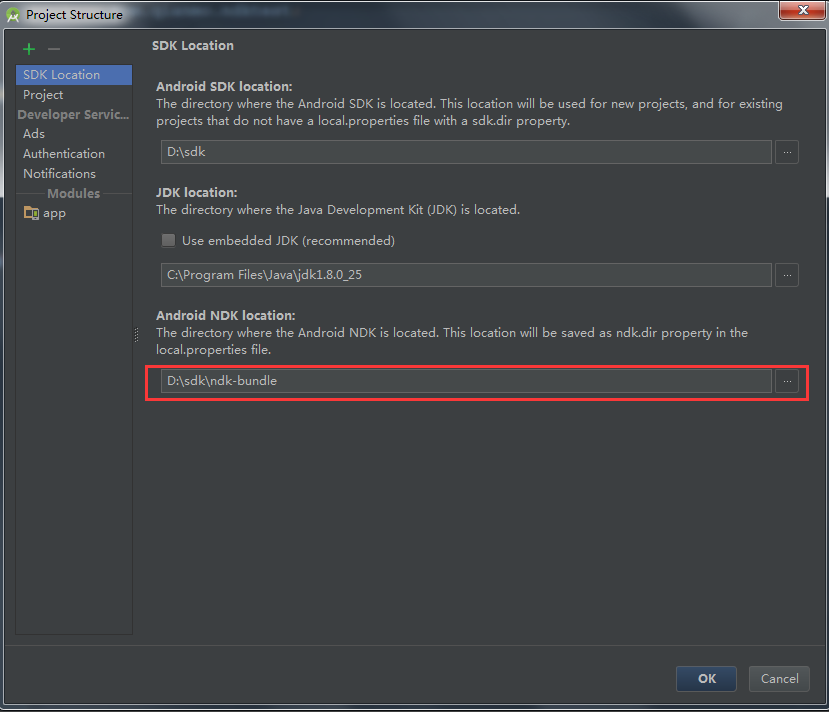1,NDK是什么?为什么要进行NDK开发?
NDK:Native Development Kit。Android应用运行在Dalvik虚拟机中。NDK允许开发人员使用本地代码语言(例如C和C++)实现应用的部分功能。这样以代码重用的形式能够给某类应用提供方便,而且在某些情况下能提高运行速度。
在实际开发中,那为什么要学习JNI,JNI会学习到比较底层的东西,java可以实现上层应用的开发,但是不能写底层驱动,有些android项目必须和底层硬件打交道,比如要精确快速的获取某种传感器的值,那么java是不能办到的,那怎么办,就通过JNI开发,通过c/c++完成底层驱动或者值得获取,然后将值传回到java层。同样java层也可以将数据传递给c/c++层,这样通过JNI完成数据的交互。常见的产品如蓝牙、运动手环等。
2,NDK环境搭建
在Android studio2.2之后就可以使用我们的Android开发工具来开发了
- 安装NDK
Tools->Android->SDK Manager->SDK Tools选中CMake和NDK,点击确认,软件会自动安装NDK。

- 将NDK添加到Android Studio环境中

配置环境变量,方便cmd中的操作,在环境变量Path添加ndk目录

在cmd中检查是否安装成功,输入ndk-build,出现如下效果即

ok,环境安装好了我们来创建项目,和我们创建Android工程类似,只不过我们要勾选“include c/c++”

一路Next ,最后创建项目,创建项目之后我们坑定有些文件没有见过,首先看一下native-lib.cpp类
#include <jni.h>
#include <string>
extern "C"
JNIEXPORT jstring JNICALL
Java_com_qianmo_ndktest_MainActivity_stringFromJNI(
JNIEnv *env,
jobject /* this */) {
std::string hello = "Hello from C++";
return env->NewStringUTF(hello.c_str());
}
什么?一脸懵逼!嗯,我现在也和你一样,不过我们查查网上的资料来看看里面的代表什么意思
其中extern “C” 是表示可以供外部调用。 jstring是返回值,maxFromJNI是Java代码中定义的函数。(过会儿会写在MainActivity里,一般是Java_包名_使用地方的类名_方法名) Java_com_qianmo_ndktest_MainActivity_这一段是调用这个函数的java类以及它所在的包。 JNIEnv* env 和 jobject object是啥我也不知道,很显然这俩必须要用,貌似第一个代表的是什么指针什么的,后面以object类型命名的猜测可能是对象吧(手动微笑)。
继续看我们Activity中调用
public class MainActivity extends AppCompatActivity {
// Used to load the 'native-lib' library on application startup.
static {
System.loadLibrary("native-lib");
}
@Override
protected void onCreate(Bundle savedInstanceState) {
super.onCreate(savedInstanceState);
setContentView(R.layout.activity_main);
// Example of a call to a native method
TextView tv = (TextView) findViewById(R.id.sample_text);
tv.setText(stringFromJNI());
}
/**
* A native method that is implemented by the 'native-lib' native library,
* which is packaged with this application.
*/
public native String stringFromJNI();
}
我们继续看看让我们懵逼的几个不熟悉的方法
//加载这个native-lib里的函数和东西
static {
System.loadLibrary("native-lib");
}
//这就是对应的c++文件中的方法了
public native String stringFromJNI();
CMakeLists.txt,等等,这怎么生成了一个txt文件呢?,我们看一看里面的内容
# For more information about using CMake with Android Studio, read the
# documentation: https://d.android.com/studio/projects/add-native-code.html
# Sets the minimum version of CMake required to build the native library.
cmake_minimum_required(VERSION 3.4.1)
# Creates and names a library, sets it as either STATIC
# or SHARED, and provides the relative paths to its source code.
# You can define multiple libraries, and CMake builds them for you.
# Gradle automatically packages shared libraries with your APK.
add_library( # Sets the name of the library.
native-lib
# Sets the library as a shared library.
SHARED
# Provides a relative path to your source file(s).
src/main/cpp/native-lib.cpp )
# Searches for a specified prebuilt library and stores the path as a
# variable. Because CMake includes system libraries in the search path by
# default, you only need to specify the name of the public NDK library
# you want to add. CMake verifies that the library exists before
# completing its build.
find_library( # Sets the name of the path variable.
log-lib
# Specifies the name of the NDK library that
# you want CMake to locate.
log )
# Specifies libraries CMake should link to your target library. You
# can link multiple libraries, such as libraries you define in this
# build script, prebuilt third-party libraries, or system libraries.
target_link_libraries( # Specifies the target library.
native-lib
# Links the target library to the log library
# included in the NDK.
${log-lib} )
继续懵逼,不过我们有搜索引擎,来看看里面的一些语句到底代表什么
# 指定cmake最低版本,如果不知道就复制吧 cmake_minimum_required(VERSION 3.4.1) # 第一个native-lib是供java调用的文件, SHARED 表示将代码编译成动态库即so库,相对 的还有一个STATIC表示静态 # 最后俩是所有cpp的名字和相对本文件的位置,这里在一个文件夹中就直接写名字了,文件有多少写多少 add_library(native-lib SHARED native-lib.cpp Max.cpp) # 我的理解是java要连接到native-lib,和一些其它的东西 target_link_libraries(native-lib)
OK,上面把基本的一些意思读懂了,那么我们就依葫芦画瓢,仿照着写一个试试呗,首先创建NDKUtils.java类,添加c++方法getStringFromC,添加hello-jin.cpp文件导入,代码如下:
public class NDKUtils {
static {
System.loadLibrary("hello-jni");//导入生成的链接库文件
}
public staticnative String getStringFromC();
}
继续我们创建hello-jin.cpp文件,并创建 getStringFromC()方法,代码如下:
#include <jni.h>
#include <string>
extern "C"
JNIEXPORT jstring JNICALL
Java_com_qianmo_ndktest_NDKUtils_getStringFromC(
JNIEnv *env,
jobject /* this */) {
std::string hello = "这里是来自与c++";
return env->NewStringUTF(hello.c_str());
}
在CMakeLists.txt文件中添加java和c++文件的链接
add_library(hello-jni SHARED src/main/cpp/hello-jni.cpp) target_link_libraries(hello-jni)
ok,这样我们就写完了,看一下我们运行的效果

OK,今天就给大家分享简单的NDK环境搭建和简单的数据获取,由于我自己也不怎么会写c/c++文件(都忘光了),所以后面我边学习边给大家继续分享NDK开发知识(有好的NDK开发知识的同学求共享呀,谢了啊)